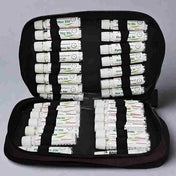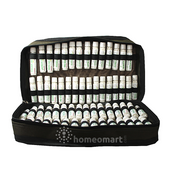Homeopathic Remedies for Age Spots – Target Pigmentation Naturally
Homeopathic Remedies for Age Spots – Target Pigmentation Naturally - Drops / Sepia Officinalis 30: For Yellow-Brownish Facial Spots is backordered and will ship as soon as it is back in stock.
Couldn't load pickup availability
Description
Description
Say goodbye to age spots and uneven skin tone! Our expert-picked homeopathic kit helps reduce pigmentation, sun damage, and facial discoloration from within – naturally, safely, and effectively.
Treat Liver Spots, Sun Damage & Pigmentation with Trusted Homeopathy
Age spots, also known as liver spots or solar lentigines, are small, dark patches on the skin. They often appear on sun-exposed areas like the face, hands, shoulders, and arms. Common in adults over 50, age spots can also affect younger individuals who spend significant time in the sun. These spots resemble cancerous growths but are harmless, resulting from overactive pigment cells. Excessive sun exposure and tanning beds can contribute to their development.
Characteristics of age spots include:
- Flat, oval areas with increased pigmentation.
- Colors ranging from tan, brown, to black.
- Commonly found on sun-exposed skin, like hands, feet, face, shoulders, and upper back.
- Sizes vary from freckle-sized to about 13 mm, often grouping together.
Risk factors for age spots include having light skin, red hair, and a history of frequent or intense sun exposure.
Homeopathic Remedies for Age Spots: A Natural Approach
Homeopathy considers individual symptoms and personal characteristics for remedy selection.
Sepia Officinalis: Targeting Yellow-Brownish Facial Spots
Sepia Officinalis 30: Effective for yellow-brownish spots on the face, especially cheeks and nose, suitable for individuals with dark hair and rigid fiber. Sudden appearance of brown spots on the skin, especially on the face, can be attributed to increased melanin production often triggered by sun exposure, aging, or hormonal changes. Factors like UV radiation can cause these spots, also known as age spots or sunspots, to form as the skin tries to protect itself from damage.
Lycopodium Clavatum: Treating Grayish-Yellow Discoloration and Digestive Issues
Lycopodium Clavatum 200: Useful for grayish-yellow facial discoloration with flatulent issues, craving for sweets, and preference for warm food. Facial discoloration can be linked to dietary cravings and flatulence due to the body's response to certain foods. For instance, cravings for specific foods might lead to overconsumption of substances that affect skin pigmentation. Additionally, digestive issues like flatulence often indicate imbalances in gut health, which can impact skin appearance, as the skin and digestive system are closely connected in overall health.
Argentum Nitricum: Remedying Sunken, Bluish Facial Skin
Argentum Nitricum 200: For sunken, old, pale, and bluish facial appearance with brown, tense, and hard skin.
Cadmium Sulphuratum: Effective for Sun-Induced Yellow Facial Stains
Cadmium Sulph 30: Addresses yellow stains on the nose and cheeks, worsening with sun and wind exposure. Yellow stains on the nose and cheeks that worsen with sun exposure are typically caused by the overproduction of melanin, the pigment responsible for skin color. Sunlight can stimulate melanin production, leading to more pronounced discoloration, especially in areas like the nose and cheeks that receive higher sun exposure. This reaction is a protective measure by the skin to shield against UV damage.
Copaiva Officinalis: Alleviating Itchy Brown Spots on Face and Hands
Copaiva Officinalis 30: For brown spots on the face and hands with itchy, mottled patches. Brown spots with itchy, mottled patches on the face and hands can be a sign of photoaging, where prolonged exposure to UV rays damages the skin, causing hyperpigmentation and texture changes. The itchiness may indicate skin irritation or an inflammatory response, often exacerbated by environmental factors or underlying skin conditions like eczema or dermatitis.
Caulophyllum Thalictroides: Addressing Moth Spots and Women's Health
Caulophyllum Thalictroides 30: Suitable for moth spots on the forehead, particularly in women with menstrual and uterine disorders. Moth spots on the forehead in women, particularly those with menstrual and uterine disorders, can be linked to hormonal imbalances. Fluctuations in hormones, especially estrogen and progesterone, during menstrual cycles or due to uterine conditions, can trigger changes in melanin production, leading to hyperpigmentation or 'moth spots' on the skin.
Thuja Occidentalis: For Waxy, Shiny Skin with Brown Spots
Thuja Occidentalis 30: For pale, waxy, shiny skin with brown spots and spider-like veins. Pale, waxy, and shiny skin with brown spots and spider-like veins can be indicative of poor circulation or venous insufficiency, which affects blood flow and can lead to skin changes. Additionally, these symptoms might also point to certain dermatological conditions where there's an alteration in skin texture and pigmentation, coupled with the visible appearance of small, dilated blood vessels.
Plumbum Metallicum: Treating Yellow Spots on Sunken Cheeks
Plumbum Metallicum 200: Addresses yellow, corpse-like spots on sunken cheeks. Yellow, corpse-like spots on sunken cheeks can be a sign of severe nutritional deficiencies or chronic illnesses that affect the skin's health and pigmentation. The sunken appearance often indicates a loss of subcutaneous fat and muscle tone, which can be associated with aging or certain medical conditions, further accentuating the discoloration.
Sulphur: Managing Rough, Dry, and Spotted Skin with Itching
Sulphur 200: Suited for unhealthy, dry, rough, and dirty skin with old-looking spotted face and itching, burning sensations, exacerbated by heat. This condition can be symptomatic of chronic skin conditions like eczema or psoriasis. These conditions are often characterized by inflammation and impaired skin barrier function, leading to dryness, irritation, and sensitivity to environmental triggers like heat.
Recommended Use:
General: (Pills) Adult and children 2 years of age and older: Dissolve 4 pills under the tongue 3 times a day until relieved or as directed by a physician. (Drops): The usual dosage is 3-4 drops in a teaspoon of water 2-3 times daily. Dosage may vary depending on the conditions
Specific: Dosage and remedy selection should be individualized. Consult a qualified homeopathic physician for the best combination and potency tailored to your case.
Source: blog article in ks-gopi dot blog spot dot com
Related Information
Related Information
Tip: Pair Berberis Aquifolium Gel with the Age Spots Homeopathy Kit remedies for a complete skin-brightening regimen - Berberis works topically to fade scars and pigmentation, while internal remedies like Sepia or Thuja target discoloration from within. Together, they offer a natural dual-action solution for clearer, more radiant skin.
Disclaimer: : The medicines listed here are solely based on suggestions made by doctors on YouTube/Blog whose reference is provided. Homeomart does not provide any medical advice or prescriptions or suggest self-medication. This is a part of the customer education initiative. We suggest you consult your physician before taking any medicines. Medicine Box Image for representative purposes only, actual may vary.
















